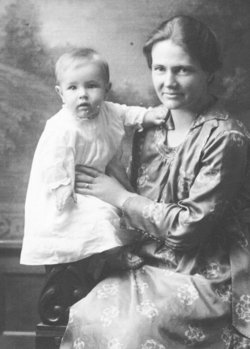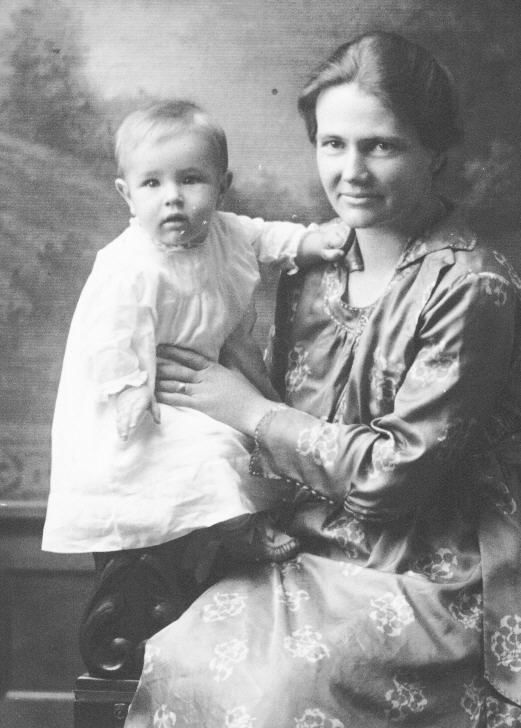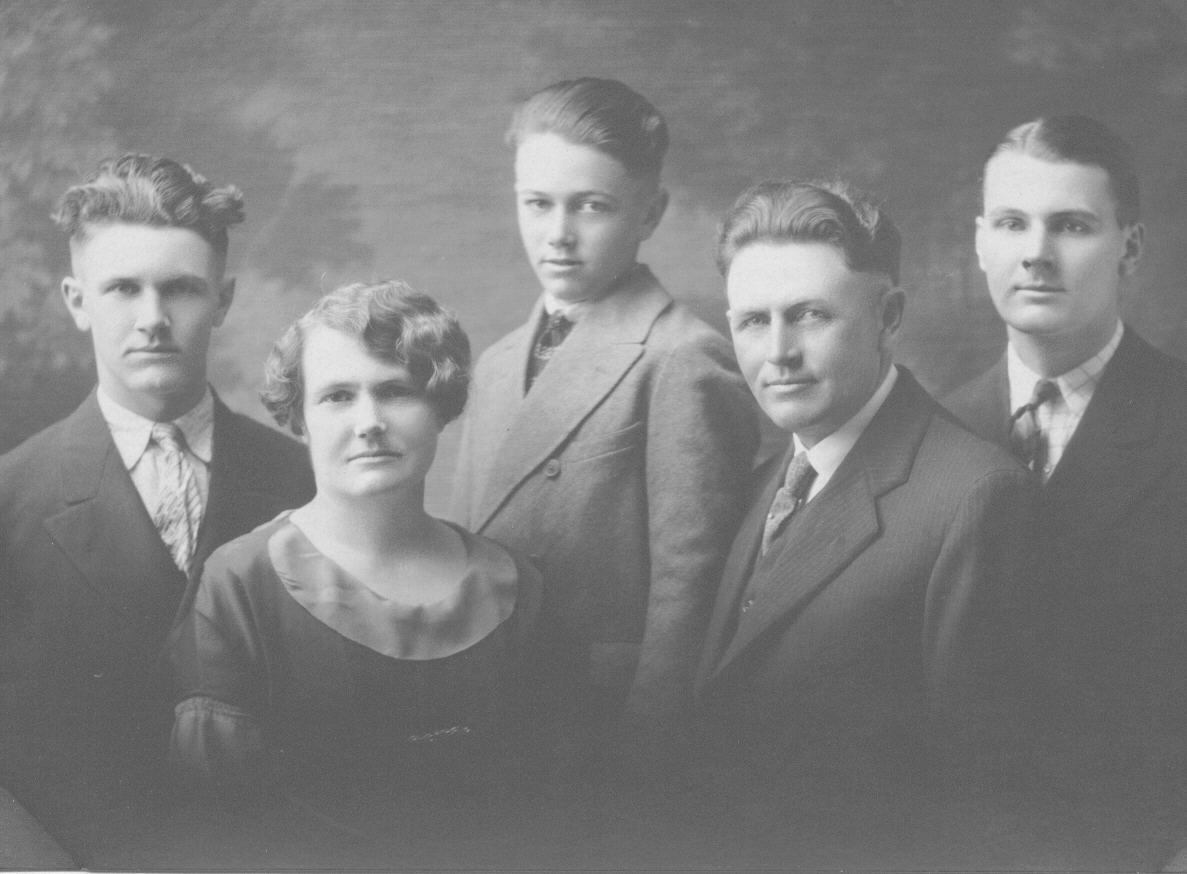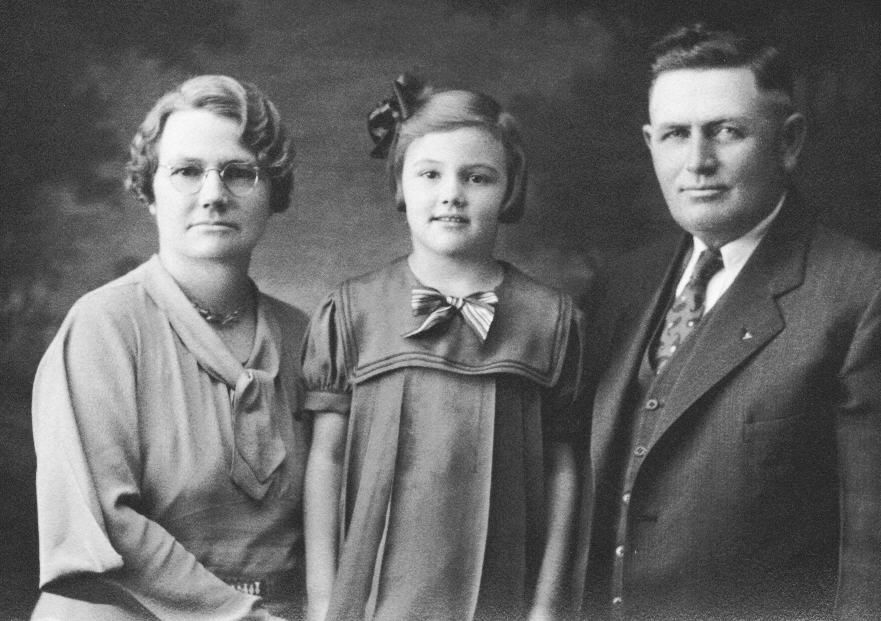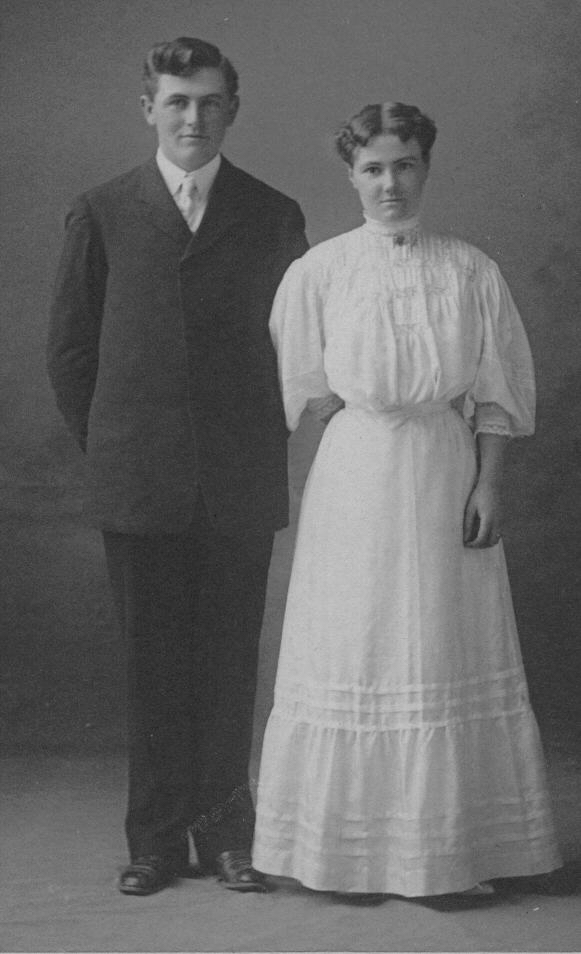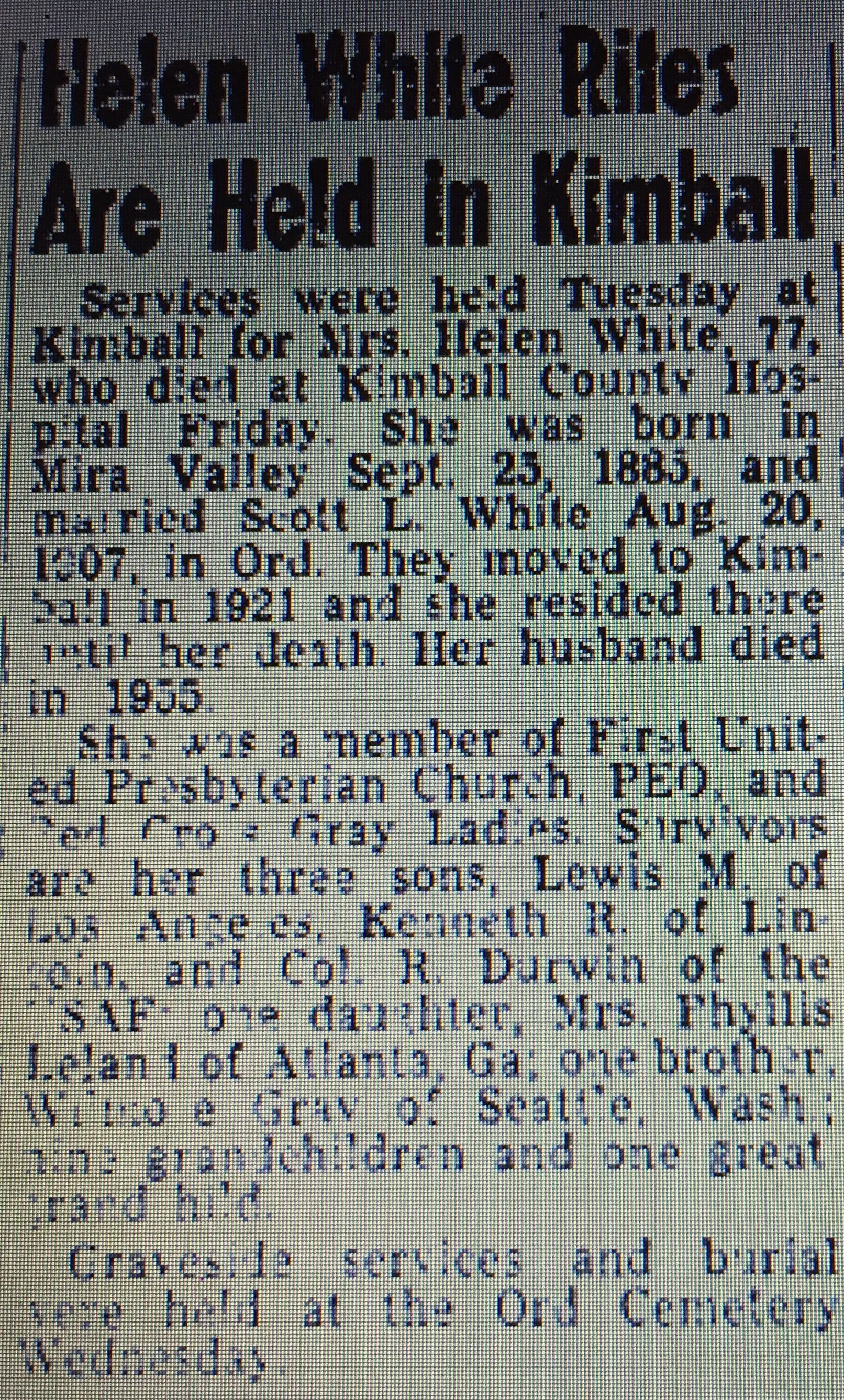Helen wrote that she had an attack of appendicitis at 2:00 AM on Friday, November 8, 1940 (age 55); and went to Flett Hospital the next evening; and was operated on the next day (Nov. 10) by Dr. McEudaffes, assisted by Dr. Rochel of Sidney, NE (because Dr. Flett was out of town). She was in the hospital for three weeks. Her appendix was found to be gangrenous and perforated. Infection had spread to her intestines. The doctors' bill was $170, and the hospital bill was $105 - for the three weeks.
The White family moved from Springdale (in east Valley County, NE) to Mira Valley in March 1909, then, in February 1910 to another farm on the east side of Mira Valley, and then from Mira Valley, south of Ord, Nebraska to Kimball, Nebraska on March 24, 1921. (In May 1920 they sold the farm in Mira Valley, and in June 1920 bought a farm in Kimball County, Nebraska.)
The following was written by Durwin White, son of Helen & Scott White:
Yielding to the lure of inexpensive virgin land and $2.50 wheat, (Whites and their four sons) came to Kimball County (Nebraska) in 1920. They shipped, from farm in Valley County, Nebraska, a hired man, a horse, a cow, a cat (which jumped out along the way), household goods, and tools all packed in a railroad box car. The family made the trip in three days in a very durable but slow 1918 Dodge touring car.
The first wheat crop from their new mortgaged farm seven miles south of Kimball, was good. This produced enough cash (net) to make down payments on a whole gamut of wheat planting and harvesting machinery. One hour and 20 minutes after the hail insurance expired at 12:00 noon a massive hail storm flattened the second year's crop the day before harvest was to start. With this total loss of the wheat went the farm, the machinery, and all the money from the old Ord farm.
Undaunted by this extreme bad luck and with a generous loan from the American State Bank the Whites entered the cattle fattening farm business on 80 acres three miles north of Kimball. During the two winters there Lewis and Kenneth, ages 15 and 12 respectively, drove a school bus (actually it was the family car) carrying seven children to and from the "city school." The "school bus," the carburetor and manifold of which required a very hot water bath (with a rear wheel jacked up) every cold winter morning to start, was a 1919 Ford coupe that had had all the top body sawed off. The $20 a month for this service was the only cash income the family had during one of those cold, cold Nebraska winters when Scott was away in South Dakota for his health. We ate a lot of jack rabbit that year. Rabbit, which could be hung under the eaves for frozen storage, when ground fine and well seasoned is not too bad in sandwiches for school lunches. If newspapers hadn't taken so much space they would have worked fairly well in
keeping the snow and mud out of holes in the soles of (our) well worn shoes. But misfortune struck again. Before the cattle could be marketed the price of beef had fallen far below acquisition costs, not to mention feed and maintenance costs. So--to town and away from farming in 1924.
You could take Scott and Helen off the farm but it would have been hard at the time to take the farm out of them. They brought a cow and chickens to a Kimball neighborhood that must surely have wished they had stayed "in the country." But they sold milk (mostly Jersey cream) for 10 cents a quart; and eggs and fryers brought in some money. Kenneth and Durwin shared the cow milking and milk delivering tasks on an alternating basis. Durwin remembers coming home late many nights, bone tired, only to find a note from mother on the kitchen table: "Don't forget to milk Strawberry and deliver the milk." Our cow Strawberry "left us" in 1928.
Helen & Scott's son Wallace caught diphtheria in 1924. With three doctors present, and while the family watched, last minute but unsuccessful surgery was performed on the dining table. Wallace was four.
In 1928 Phyllis Carol White was born in good health just a few days after Helen, age 42, Kenneth and Durwin were released from a six weeks quarantine for smallpox. Phyllis graduated from Kimball County High School and became a medical technician after studies in Atlanta, Georgia. She now lives with her daughter, Barbara, in Torrance, California.
Scott held a variety of salaried jobs in Kimball from 1925 to 1955, the last being manager of the City Street Department and Skating Rink. He served for a time as Deputy Sheriff, and was active in the Presbyterian Church and was a member and President of the Kimball School Board for several years. he passed away in 1955.
Helen, in in addition to mothering four boys and a daughter in tough times and good, was active in the Presbyterian Church and served as city librarian (over the old Post Office) for two years. She also was an active member of P.E.O., which gave her great pleasure. She passed away in Kimball in 1963.
Lewis was prominent in Kimball High School athletics, particularly football. He attended Hastings College and graduated from the University of Georgia. He occupied important positions with several corporations the last of which was Hughes Aircraft Co., in California. During WWII he served three years in the Navy. He was especially proud of his contributions to the Hughes Surveyor Moon Probe. He died in 1978 in Torrance, California, after several years of volunteer hospital and church work.
After graduating from Kimball County High School, Kenneth attended the University of Nebraska. He was exceptionally athletic, taking significant honors in grade school, high school and college sports. At 14, frustrated by a family ruling against games on Sunday, he made quite a mark in Sunday afternoon baseball under an assumed name. (His folks, although avid readers of the "Observer," never found out.) His executive career with the Continental Oil Company was temporarily interrupted for WWII service in the Navy. Although now in retirement, he spends almost full time as a resource person for the International Prayer Breakfast Movement. he and his wife Harriet live in Estes
Park, Colorado.
Durwin, best remembered in Kimball, Nebraska for his singing, (although he was also active in high school and college sports) attended the University of Wyoming, graduated from the University of Georgia and the University of Chicago, entered the Army as a second Lieutenant in 1940 and retired from the Air Force in 1964 in the grade of Colonel. Retiring again in 1976 after a second career in merchandising, he now does volunteer work at the Air Force Hospital in Tucson, Arizona where he lives with his wife Evelyn and 16 year old son, Ricky.
The economic and environmental hostility that plagued the White's early years in Kimball County eventually gave way to the conviction that: "This IS our home--where we ARE supposed to be." Scott never lost faith in himself or in Kimball County. Helen, early on, got over her homesickness for central Nebraska. Scott and Helen did not acquire great material wealth. But they lived full and productive lives, always provided for and set exceptionally fine examples for their children AND amassed a vast fortune in solid friendships.
(Taken from the book "Kimball County Nebraska--100 Years")
Helen was reportedly somewhat stern and rigid, and yet could sometimes be fun. ("Stern and rigid" was something of a Gray trait, yet the Grays were good, solid, loving people.)
Helen wrote that she had an attack of appendicitis at 2:00 AM on Friday, November 8, 1940 (age 55); and went to Flett Hospital the next evening; and was operated on the next day (Nov. 10) by Dr. McEudaffes, assisted by Dr. Rochel of Sidney, NE (because Dr. Flett was out of town). She was in the hospital for three weeks. Her appendix was found to be gangrenous and perforated. Infection had spread to her intestines. The doctors' bill was $170, and the hospital bill was $105 - for the three weeks.
The White family moved from Springdale (in east Valley County, NE) to Mira Valley in March 1909, then, in February 1910 to another farm on the east side of Mira Valley, and then from Mira Valley, south of Ord, Nebraska to Kimball, Nebraska on March 24, 1921. (In May 1920 they sold the farm in Mira Valley, and in June 1920 bought a farm in Kimball County, Nebraska.)
The following was written by Durwin White, son of Helen & Scott White:
Yielding to the lure of inexpensive virgin land and $2.50 wheat, (Whites and their four sons) came to Kimball County (Nebraska) in 1920. They shipped, from farm in Valley County, Nebraska, a hired man, a horse, a cow, a cat (which jumped out along the way), household goods, and tools all packed in a railroad box car. The family made the trip in three days in a very durable but slow 1918 Dodge touring car.
The first wheat crop from their new mortgaged farm seven miles south of Kimball, was good. This produced enough cash (net) to make down payments on a whole gamut of wheat planting and harvesting machinery. One hour and 20 minutes after the hail insurance expired at 12:00 noon a massive hail storm flattened the second year's crop the day before harvest was to start. With this total loss of the wheat went the farm, the machinery, and all the money from the old Ord farm.
Undaunted by this extreme bad luck and with a generous loan from the American State Bank the Whites entered the cattle fattening farm business on 80 acres three miles north of Kimball. During the two winters there Lewis and Kenneth, ages 15 and 12 respectively, drove a school bus (actually it was the family car) carrying seven children to and from the "city school." The "school bus," the carburetor and manifold of which required a very hot water bath (with a rear wheel jacked up) every cold winter morning to start, was a 1919 Ford coupe that had had all the top body sawed off. The $20 a month for this service was the only cash income the family had during one of those cold, cold Nebraska winters when Scott was away in South Dakota for his health. We ate a lot of jack rabbit that year. Rabbit, which could be hung under the eaves for frozen storage, when ground fine and well seasoned is not too bad in sandwiches for school lunches. If newspapers hadn't taken so much space they would have worked fairly well in
keeping the snow and mud out of holes in the soles of (our) well worn shoes. But misfortune struck again. Before the cattle could be marketed the price of beef had fallen far below acquisition costs, not to mention feed and maintenance costs. So--to town and away from farming in 1924.
You could take Scott and Helen off the farm but it would have been hard at the time to take the farm out of them. They brought a cow and chickens to a Kimball neighborhood that must surely have wished they had stayed "in the country." But they sold milk (mostly Jersey cream) for 10 cents a quart; and eggs and fryers brought in some money. Kenneth and Durwin shared the cow milking and milk delivering tasks on an alternating basis. Durwin remembers coming home late many nights, bone tired, only to find a note from mother on the kitchen table: "Don't forget to milk Strawberry and deliver the milk." Our cow Strawberry "left us" in 1928.
Helen & Scott's son Wallace caught diphtheria in 1924. With three doctors present, and while the family watched, last minute but unsuccessful surgery was performed on the dining table. Wallace was four.
In 1928 Phyllis Carol White was born in good health just a few days after Helen, age 42, Kenneth and Durwin were released from a six weeks quarantine for smallpox. Phyllis graduated from Kimball County High School and became a medical technician after studies in Atlanta, Georgia. She now lives with her daughter, Barbara, in Torrance, California.
Scott held a variety of salaried jobs in Kimball from 1925 to 1955, the last being manager of the City Street Department and Skating Rink. He served for a time as Deputy Sheriff, and was active in the Presbyterian Church and was a member and President of the Kimball School Board for several years. he passed away in 1955.
Helen, in in addition to mothering four boys and a daughter in tough times and good, was active in the Presbyterian Church and served as city librarian (over the old Post Office) for two years. She also was an active member of P.E.O., which gave her great pleasure. She passed away in Kimball in 1963.
Lewis was prominent in Kimball High School athletics, particularly football. He attended Hastings College and graduated from the University of Georgia. He occupied important positions with several corporations the last of which was Hughes Aircraft Co., in California. During WWII he served three years in the Navy. He was especially proud of his contributions to the Hughes Surveyor Moon Probe. He died in 1978 in Torrance, California, after several years of volunteer hospital and church work.
After graduating from Kimball County High School, Kenneth attended the University of Nebraska. He was exceptionally athletic, taking significant honors in grade school, high school and college sports. At 14, frustrated by a family ruling against games on Sunday, he made quite a mark in Sunday afternoon baseball under an assumed name. (His folks, although avid readers of the "Observer," never found out.) His executive career with the Continental Oil Company was temporarily interrupted for WWII service in the Navy. Although now in retirement, he spends almost full time as a resource person for the International Prayer Breakfast Movement. he and his wife Harriet live in Estes
Park, Colorado.
Durwin, best remembered in Kimball, Nebraska for his singing, (although he was also active in high school and college sports) attended the University of Wyoming, graduated from the University of Georgia and the University of Chicago, entered the Army as a second Lieutenant in 1940 and retired from the Air Force in 1964 in the grade of Colonel. Retiring again in 1976 after a second career in merchandising, he now does volunteer work at the Air Force Hospital in Tucson, Arizona where he lives with his wife Evelyn and 16 year old son, Ricky.
The economic and environmental hostility that plagued the White's early years in Kimball County eventually gave way to the conviction that: "This IS our home--where we ARE supposed to be." Scott never lost faith in himself or in Kimball County. Helen, early on, got over her homesickness for central Nebraska. Scott and Helen did not acquire great material wealth. But they lived full and productive lives, always provided for and set exceptionally fine examples for their children AND amassed a vast fortune in solid friendships.
(Taken from the book "Kimball County Nebraska--100 Years")
Helen was reportedly somewhat stern and rigid, and yet could sometimes be fun. ("Stern and rigid" was something of a Gray trait, yet the Grays were good, solid, loving people.)
Family Members
Sponsored by Ancestry
Advertisement
Explore more
Sponsored by Ancestry
Advertisement
